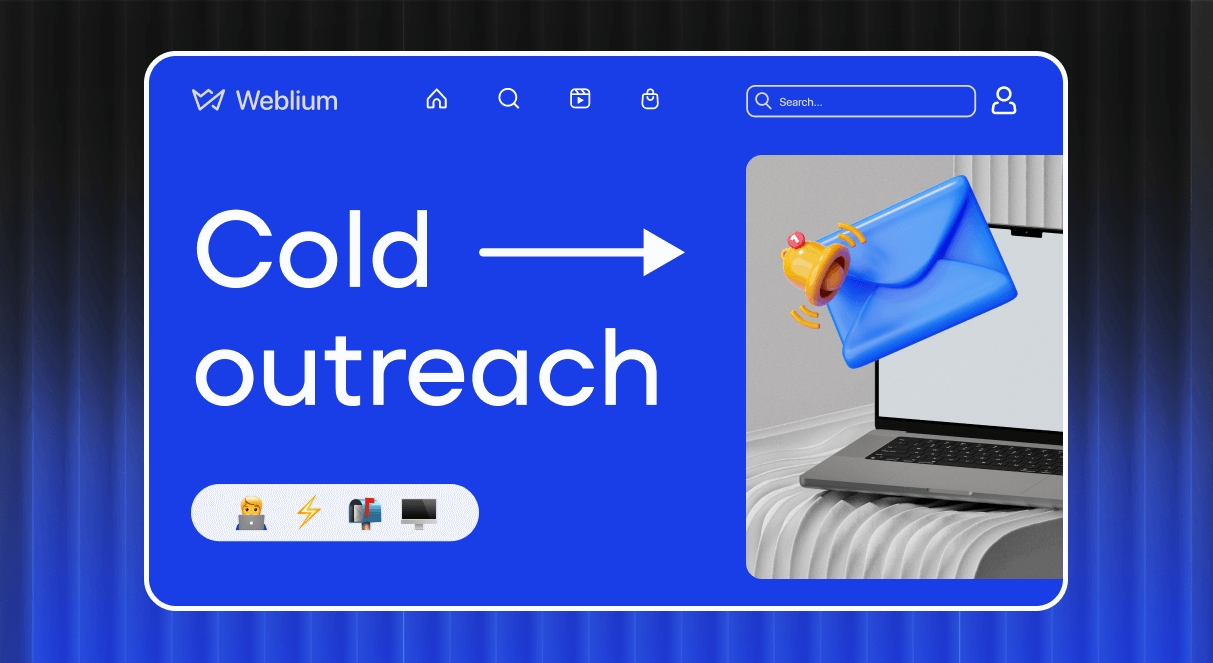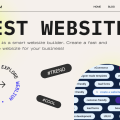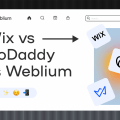
Cold Outreach for Agencies: Where to Begin This Year
Let’s face it, cold outreach can feel a bit intimidating.
The idea of reaching out to strangers, hoping they’ll become your clients, often feels like a shot in the dark.
But in 2025, cold outreach isn’t just about sending random emails and crossing your fingers. It’s about smart strategies, personalized messaging, and leveraging the right tools like Weblium and Reply to connect with potential clients in a meaningful way.
No matter if you’re running a digital marketing agency, a creative studio, or any other type of service-based business—effective cold outreach can open doors to opportunities you might not even know exist.
So, where do you begin?
Contents
How can agencies find clients?

First things first: social media is a powerful tool.
Platforms like LinkedIn, Twitter (or name it x.com—you choose), and Instagram are excellent for finding clients.
- On LinkedIn, engage by joining relevant groups and participating in discussions. Level up your Social Selling Index for success.
- Twitter (or x.com, whatever!) is great for following industry hashtags and joining real-time conversations.
- Instagram allows you to showcase your work through visuals and stories, reaching the right audience with targeted hashtags.
While social media is essential, don’t overlook in-person networking.
Attend industry conferences, local meetups, and trade shows. These events are prime opportunities to meet potential clients face-to-face. Look for conferences where your ideal clients are and consider speaking or sponsoring.
Smaller gatherings like local meetups can also be effective.
Content marketing is another key strategy. Start a blog on your website on Weblium to share insights, case studies, and industry trends. But, make sure your content is SEO-friendly to attract organic traffic (don’t worry, Weblium’s got everything you need).

Writing guest posts for other industry blogs can help you reach a broader audience. Hosting webinars or starting a podcast allows you to dive deep into topics and interact with potential clients in real-time.
There are some places where you can get some support, like freelance platforms like Upwork or Fiverr to find clients, especially when starting out. The only point here is that you need to create a compelling profile and bid on projects that match your skills to build your portfolio.
Lastly, our today’s hero, cold outreach, is still a viable strategy. Craft personalized, value-driven emails and be persistent with follow-ups, offering additional value like useful articles or case studies.
Let’s see why this channel can be so impactful.
Why is cold outreach the best way to find clients?
Cold outreach stands out as one of the best ways to find clients because it’s direct, personal, and highly targeted. Unlike passive methods, cold outreach allows you to take the initiative and reach out to potential clients who might not have discovered your services otherwise.
First, it’s all about personalization.
When you craft a personalized email that speaks directly to a potential client’s needs and pain points, it shows you’ve done your homework. This personal touch can make a huge difference (like, really HUGE!), grabbing their attention and setting you apart from generic marketing messages.
Additionally, cold outreach is highly targeted.
You can focus on specific industries, companies, or even individuals who are a perfect fit for your services. This precision means you’re spending your efforts on high-potential leads rather than casting a wide, uncertain net.
Moreover, cold outreach can lead to immediate conversations. Unlike waiting for inbound to generate you leads, you can directly engage with decision-makers, opening the door to quick feedback and potential partnerships.
Finally, cold outreach builds relationships. Even if the initial response isn’t a yes, you’ve started a conversation. With consistent follow-ups and added value, these relationships can develop into long-term clients.
Want to know how to build your own cold outreach powerhouse? Let’s dive right in.
How do you start cold outreach in 6 simple steps?
Starting cold outreach might seem daunting, but by following these 6 steps, you’ll be well on your way to building an effective strategy that gets results.

Ready to get started?
1. How do you define your targets?
First things first, you need to know who you’re reaching out to.
Define your ideal client by considering factors like industry, company size, job titles, and specific needs your service can address. This helps narrow down your focus and ensures you’re reaching out to the right people who are most likely to benefit from your services.
2. How do you understand your target audience?
Next, get to know your target audience. Dive deep into their pain points, challenges, and goals.
What keeps them up at night? What solutions are they currently using? Understanding these aspects allows you to tailor your outreach in a way that resonates with them. Check out industry forums, social media discussions, and reviews to gather insights.
Don’t know where to start—use AI tools like AI SDR by Reply.io, which can help you work out the ideal customer profile in a few seconds.
3. How do you build a list of potential clients?
Once you know who you’re targeting and what they need, it’s time to build your list. Use tools like LinkedIn Sales Navigator, Reply Data, industry directories, and even good old Google searches to compile a list of potential clients.
But make sure to include relevant contact information, like email addresses and LinkedIn profiles, to make your outreach easier.
4. How do you craft a compelling message?
Now comes the fun part—crafting your message.
Your outreach needs to be personalized and value-driven, including your USP. Start with a strong subject line that grabs attention. In the body, briefly introduce yourself and your agency, explain why you’re reaching out, and highlight how you can solve their specific problems.
Keep it concise and end with a clear call to action, like scheduling a call or a meeting.
5. Which channels should you choose for outreach?
Choosing the right channels is crucial. Email is a classic and effective choice for cold outreach, but don’t ignore other channels like LinkedIn, Whatsapp, or even direct cold calls, depending on your target audience.
A multi-channel approach can increase your chances of getting noticed.
6. What tools should you use for cold outreach?
Finally, equip yourself with the right tools. Sales engagement tools like Reply can help manage and scale your outreach efforts. LinkedIn tools like Sales Navigator are great for building and engaging with your list.
CRM systems like HubSpot or Pipedrive (or even built-in CRM in Weblium) can keep track of your interactions and follow-ups, ensuring no potential client falls through the cracks. Additionally, using outbound dialers for cold calling and marketing tools to maximize your outreach can significantly boost your results. And don’t forget, your potential customers want to know more about you. Building a website on Weblium is really easy and fast. It’s a great way to showcase your story and convince them to book a meeting.
How do you track your results?
Alright, you’ve started your cold outreach. Now, how do you make sure it’s working? Tracking your results is key to understanding what’s effective and what needs tweaking.
First, set clear goals. Whether it’s booking meetings, achieving a specific response rate, or converting leads into clients, having clear goals helps measure success effectively.
It’s simple—just use a CRM. These tools track every interaction, follow-up, and response in one place, ensuring you never lose track of your leads.
Focus on key metrics: open rates, response rates, and conversion rates.
Open rates show if your subject lines are working, response rates indicate if your message resonates, and conversion rates reveal how many leads become clients.
Qualitative feedback is equally important. Pay attention to responses to understand potential clients’ thoughts and concerns, refining your message accordingly.
A/B testing different subject lines, email formats, and messaging styles helps optimize your outreach. Regularly review performance data to spot patterns and trends, such as the best times to send emails or the most responsive industries.
Stay flexible and ready to adapt based on the data. Tracking results might seem daunting, but it ensures your cold outreach efforts are effective, helping you achieve better results over time.
How do you build a scalable process?
Building a scalable process for cold outreach ensures you can handle growth without sacrificing quality. Here’s how to do it.
First, standardize your workflow. Create templates (or use AI email generators to ease the process) for your emails and follow-ups that can be easily customized.
This saves time and maintains consistency.
Next, use automation tools. Platforms like Reply with its AI SDR allow you to automate email sequences and follow-ups. This way, you can reach more people without increasing your workload.

Document your process. Write down every step of your outreach strategy, from defining targets to crafting messages. This documentation makes it easier to train new team members and maintain consistency as you scale.
Outsource repetitive tasks. Use virtual assistants or freelancers to handle tasks like building lists or scheduling follow-ups. This frees up your time for more strategic activities.
Regularly review and refine your process. As you grow, continually assess what’s working and what’s not. Use data to make informed adjustments, ensuring your process remains effective at scale.
What’s the future of cold outreach for agencies?
Looking ahead, the future of cold outreach for agencies is buzzing with exciting trends. While the basics of personalized, value-driven communication stay the same, some cool new trends are emerging.
First off, automation and AI are real game-changers. AI SDRs are taking over repetitive tasks and giving insights on the best times to reach out, the most effective messages, and the right audience.
This makes outreach more efficient and data-driven, allowing agencies to scale up without losing that personal touch.
Next, there’s the trend of omnichannel outreach. Cold outreach isn’t just about emails anymore. It’s about reaching out through social media, SMS, and even video messages. Meeting potential clients where they’re most active increases the chances of getting noticed.
Hyper-personalization is also key. Generic messages are out; people want tailored communications that address their specific needs. Using data to craft these personalized messages will help you stand out.
Building relationships over quick wins is becoming the norm. Agencies are focusing more on nurturing long-term relationships. This means consistent follow-ups, providing ongoing value, and building trust over time, leading to loyal clients.
So, the future of cold outreach is bright and full of opportunities. By embracing these trends, agencies can keep their outreach efforts fresh and effective, ensuring continued growth and success.
Wrapping it up
Cold outreach might seem tricky, but it’s totally doable with the right moves.
Use social media, hit up networking events, create awesome content with Weblium, and take advantage of AI and automation tools with Reply.
It’s all about making things personal and building real connections. Keep at it, tweak your approach as you go, and watch those cold leads turn into loyal clients.
Here’s to rocking your outreach in 2025!


